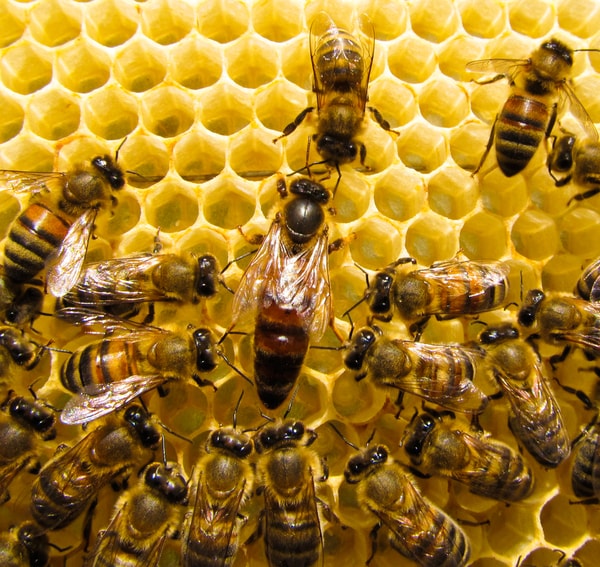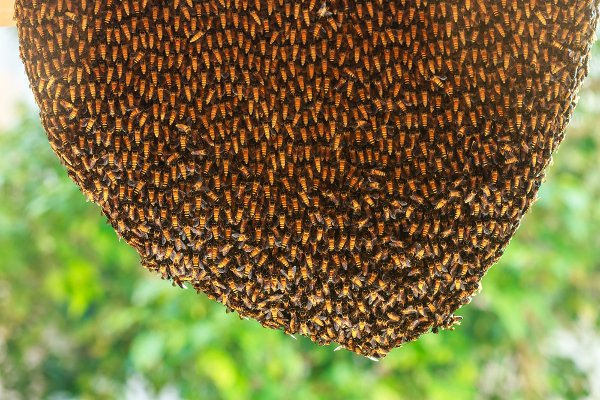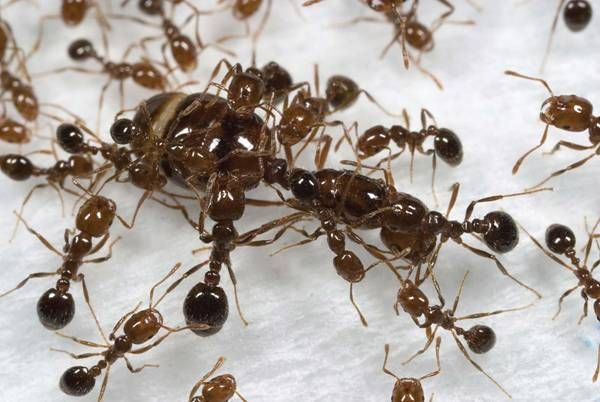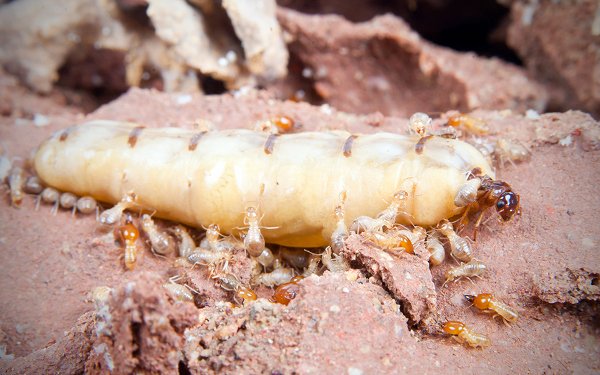Eusocial Colonies - Keeping it in the Family
G'day team
Today I thought we could have a chat about a bit of a quirk of evolution known as eusocial organisms. These animal form phenomenally close colonies, usually as a result of inadvertently upsetting the usual genetic link between parents and children.

Image source
What is Eusocial?
We all know that many members of the animal kingdom form colonies or packs, and at least in part work together to protect and provide for each other. But for most animals, even those in massive colonies, the end-game is always to find a mate and make some babies.
Eusocial organisms work differently. They form large colonies full of individuals of specialized castes, and while once again these individuals all work towards the common good of the colony, in this case, not every individual is capable of reproducing. Instead many members of the colony exist ONLY to support the reproductive-heavy lifestyle of a single 'queen' or group of 'queens'.
The most obvious examples here are ants and bees, but as we'll see, there are eusocial organisms all across the animal kingdom and this particular social order has evolved independently on multiple occasions.
All eusocial organisms, by definition, must display the following three traits...
1. Division of Labor
Eusocial organisms live in colonies where individuals are divided into 'castes'. Many castes are highly specialized for a single role (gathering, digging, hunting, nursing etc.) and generally, individuals of these'worker' casts cannot reproduce.
2. Cooperative Brood Care
*This refers to the nursery-like structure of eusocial raising of children. Think daycare, but on a massive scale and from birth. In eusocial the young are raised in groups, often by a specific nursing caste, and collective care for all infants is shared among many individuals.
3. Overlapping generations within a group of adults
When adults in a colony represent a number of different generations, it indicates that longevity and work are the most important aspect of the caste. These individuals are kept around to keep working, not to breed, and by saving energy and not developing sexual organs and traits they can pour more into their labor!
Evolution of Eusocial
In a world where we always hear about the survival of the fittest and the persistence of evolution it, must seem odd that entire species of organisms have evolved to have colonies full of workers that can't reproduce... how can this be the most effective method of passing on genes?
To understand this we have to do a little evolution-maths. So let's break it down...
1. The goal of evolution
The goal of evolution is to pass on genetic material. Most sexual organisms contain two copies of their DNA, one from their mum and one from their dad. When they mate they pass on half of this, and their partner, in turn, passes on half of their own. This produces an offspring which contains half of the genome of each parent. So from the perspective of the parent (both the mother and the father), they've passed on half their genome per child. Let's call this 0.5 Genome Points (GP) per child.
2. Eusocial Haplodiploidy
Now many, but not all, eusocial organisms don't exactly comply with the tried-and-true formula above. This is because of how gender is selected in these species, let's take ants for an example.
- Male ants develop from an unfertilized egg - having only one set of chromosomes
- Female ants develop from a fertilized egg - having two sets of chromosomes
this means our 'Genome Points' from offspring now need to be recalculated
- A male is only needed to produce female, he will pass 100% of his genome to his daughters
- A female will pass 50% of her genome to either her daughters or her sons
so this gives us
- Male gets 1.00 GP for a daughter
- Female gets 0.50 GP for a daughter or a son
here's where things get interesting
- Sisters share 100% of their paternal genome (fathers side) with ALL of their sisters, and 50% of their maternal genome (mothers side), let's do the maths quickly {(1.000.50GP)+(0.500.50GP)}=0.75 GP
So each female shares 75% of her genome with her sisters. From an evolutionary perspective, and in terms of supporting the progress of one's own genome, it makes more sense for females to support the production of more sisters (with whom they share 75% of their genome) than it does to create their own offspring (with whom they will only share 50% of their genome).
- Sister is 0.75GP
- Child is 0.50 GP
Now this concept of including all genetic relatives as potentials to pass on a genome (and not just offspring) is called 'inclusive fitness' and it doesn't really apply to all eusocial organisms. It does require a haplodiploidy genome and not every eusocial organism, so we have a few other theories that help explain why the eusocial life is present across the whole animal kingdom.
Beyond Haplodiploidy
The one trait that is seen in every eusocial organisms and colony is a monogamous mating partnership in the queen or head breeder. This ensures that siblings who're supporting the colony and by extent supporting a queen's production of offspring, are at least 50% related to their siblings.
Formation of group or colony living is vital to eusocial organisms. There no point having an all-powerful hive if individuals don't get along! As such eusocial organisms work very well in groups and not only cooperate but avoid in-fighting and will actively sacrifice for the protection or furtherment of their colonies.
In eusocial colonies we also generally see what is called a 'high cost of dispersal' meaning it's quite difficult for individuals in one colony to go off and find mates, even if they were to try. This would explain why they instead opt to stay at home and help the parents extend their family! There's not much benefit to going off and trying to start your own family if there are no suitable mates for a thousand miles.
The final push that appears to push these cooperative, isolated coloonies into eusocial structures is a competitiveness with other colonies of the same species. In these cases when competing for scarce resources the winner will be who can produce the largest colony the quickest. As we've seen the eusocial model allows for a single reproductive individual to take over all breeding responsibilities while workers look after the young, spread and develop the nest. This has a clear advantage over colonies where each individual has to spend time courting, mating, and nursing young.
Some Examples
So let's get down to the fun stuff. What animals work like this?
Bees & Wasps
Many bee species and some wasps are eusocial. They'll form large hives with a single queen and have some of the most unique communication methods in the entire animal kingdom.

Image source
Ants & Termites
Most ant and termite species classify as eusocial. In many ant colonies, multiple queens may arise and produce offspring which cooperate, however, the queens will generally remain spacially quite separate, highlighting that they're forming a mega-colony, not so much breaking down the eusocial nature of the group.

A Queen Ant
Image source

A Queen Termite
Image source
Naked Mole-Rats and Damaraland Mole-Rats
While they're both mammalian species and do not exhibit haplodiploidy, Naked Mole-Rats and Damaraland Mole-Rats, at least in part, as eusocial colonies. When resources are not sufficient to intermingle with other colonies and breed naked mole rats will support a single breeding queen, raise young in groups and all working individuals will keep sterile.

Image source 1 Image source 2
Shrimp
There are a number of species of shrimp which are all eusocial. They have evolved separately by convergent evolution and all rely on a caste of fighting shrimp to protect their coral fortresses.

Image source
Are Humans Eusocial?
Does a caste system with a worker class sound familiar? Are humans eusocial? The question has been put forward on a number of occasions, most notably by Edward O. Wilson. The short answer is no. For one good reason. We don't have a sterile class. Case closed (at least till we start moving into eugenics)! :)
Thanks
Thanks for reading, I hope you all learned something interesting and had as much fun reading as I did writing
Thanks team
-tfc
Resources
Nature Education
Britanica
Eusociality: Origin and consequences
NCBI
My Animal Posts
How Chaemleons Change Their Skin
Natures Best Mother - The Great Pacific Octopus
The Oldest Caterpillar
This is a test comment, notify @kryzsec on discord if there are any errors please.
Being A SteemStem Member
It's so funny how some humans get angry when you refer to them as higher animals yet in technical terms we are animals. However if you compare our social lives and cooperation as well as submission to higher authorities, to behavioral pattern of smaller animals one would be tempted to call them higher animals and probably refer to human as lower animals. Not mean to offend humanity, I'm just relating this post. Good work sir
Haha thanks mate. I'd agree we only earn the title 'higher' due to a good communication and reasoning skills, but our social structure is not exactly advanced!
This was insanely informative and well written. Thanks for sharing, I will certainly looking out for more by you!
Thanks for the support :)
Bees that produce honey provide many benefits.
and then we have feminists busting our b@@. why they don't scream about bees and ants rights? :P
Seriously now i had no clue about the genomes, that was really interesting
i upvoted you....upvote me
https://steemit.com/download/@arjunrai/see-you-again
I know you're new to steemit mate, but we don't do this. Don't request upvotes and don't post on other people writing just to trade votes.